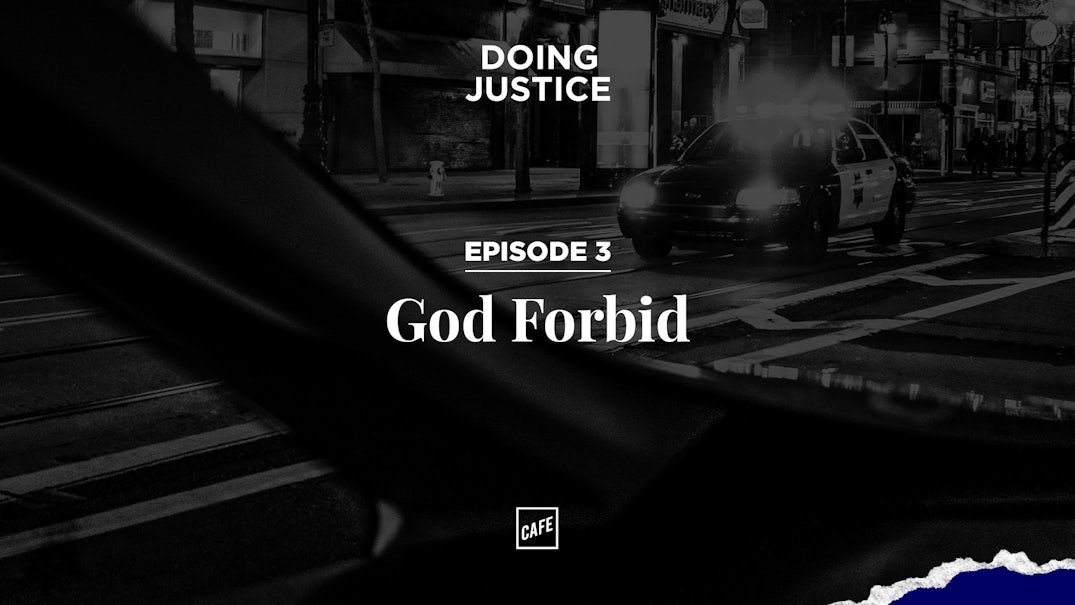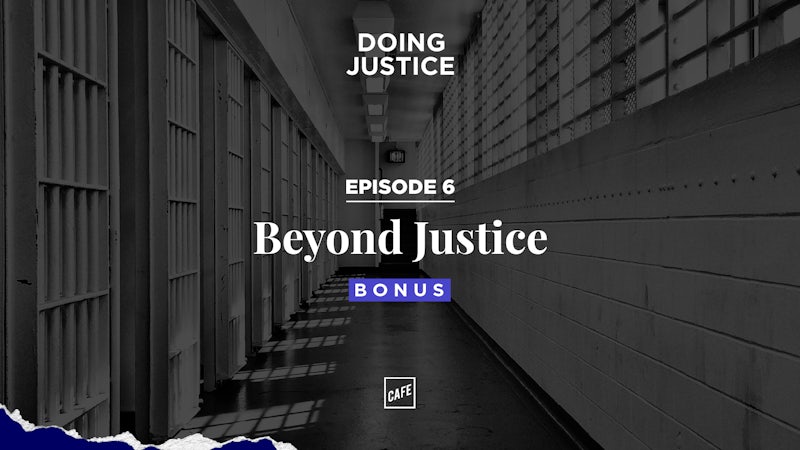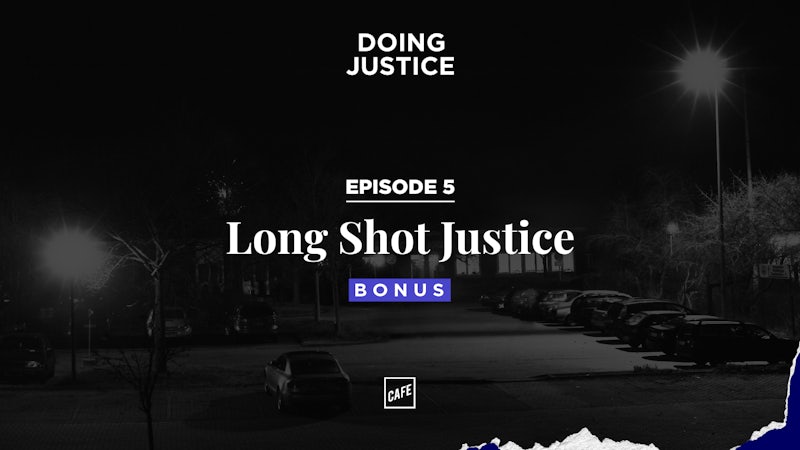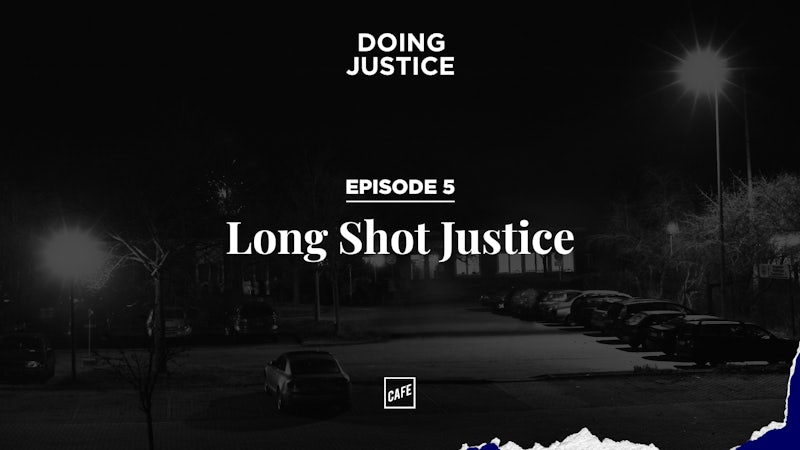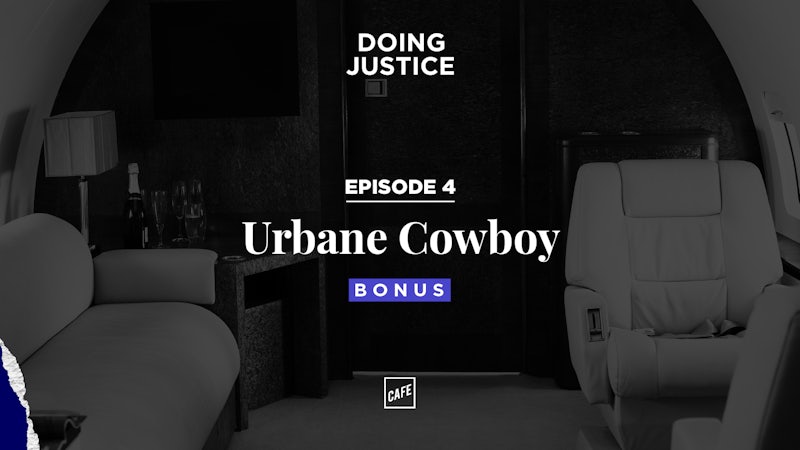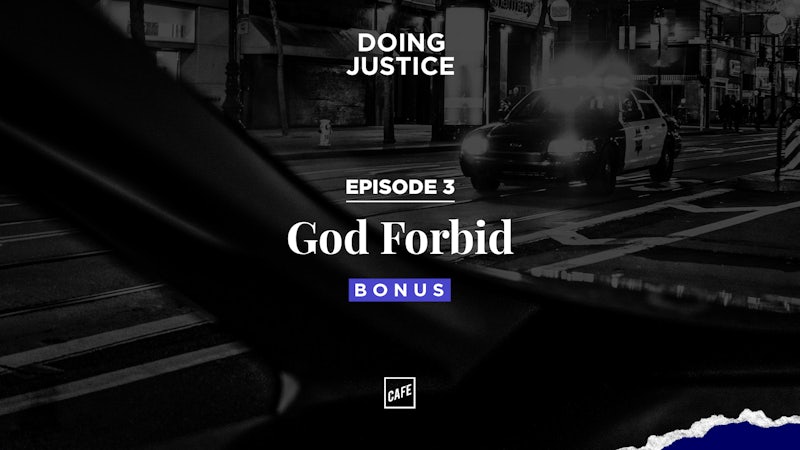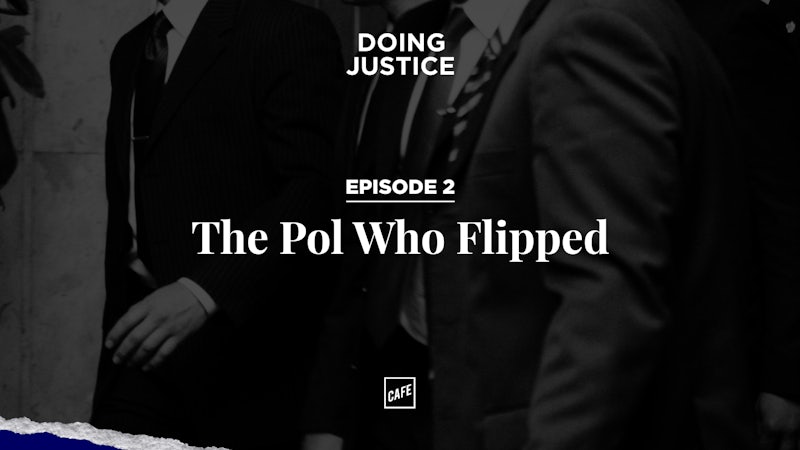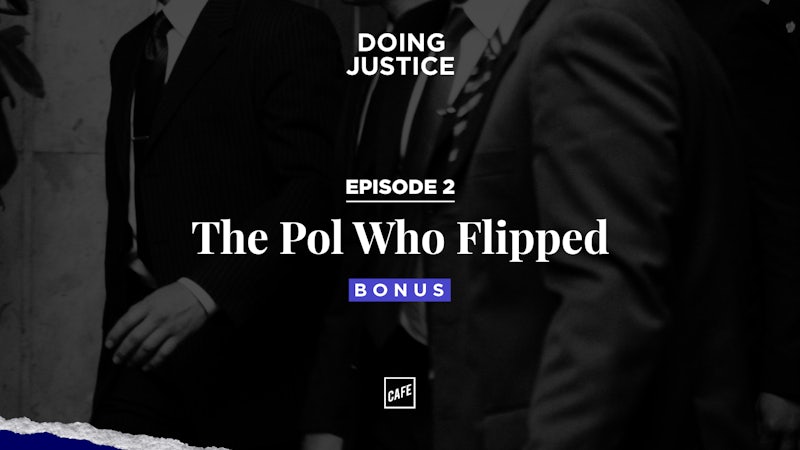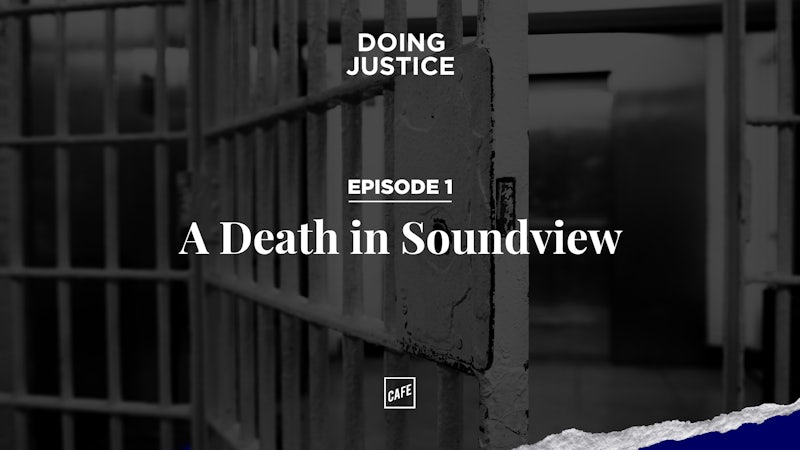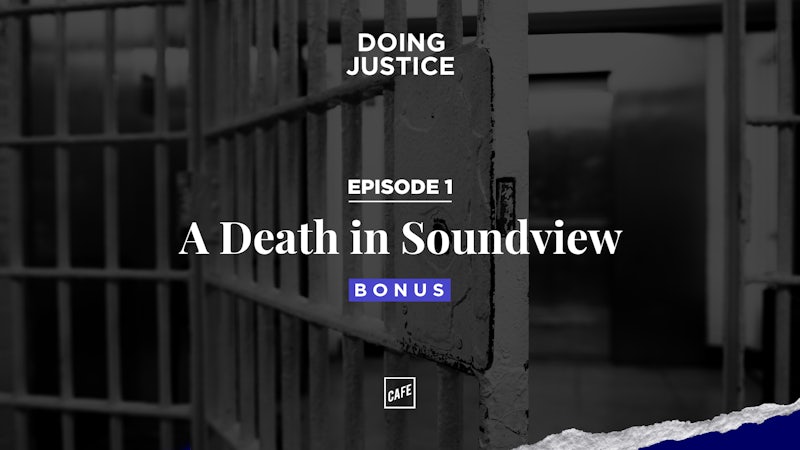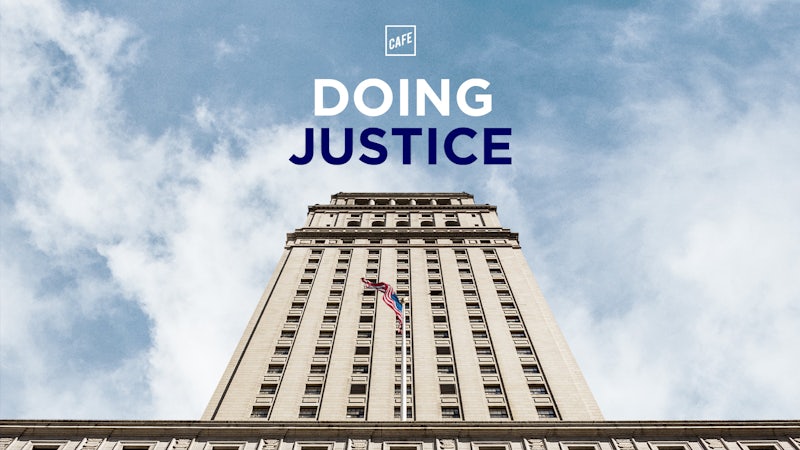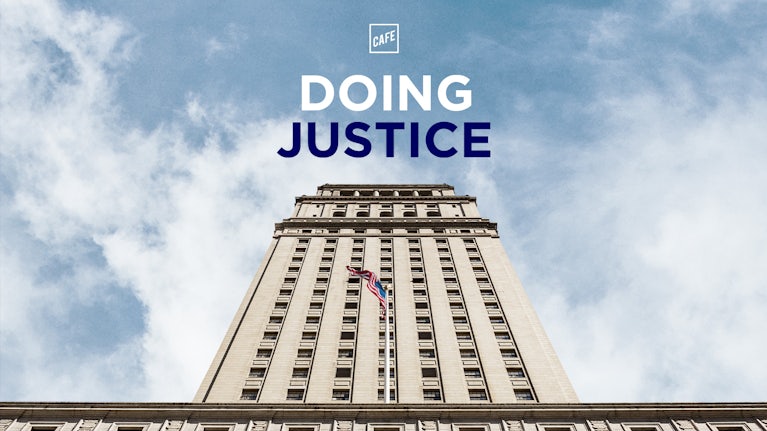Preet Bharara:
Hey folks, this episode contains graphic descriptions of violence and sexual assault, and it may not be suitable for all listeners.
Seriously, this is one of the most disturbing stories I’ve come across in my time at SDNY. But it’s an important story that sheds light on what we do and why.
Kathleen Mangan had been married for less than a year when her husband stopped coming to bed. This is a reenactment of what she said…
Kathleen Mangan (reenactment):
He always said that, because he got home late, he couldn’t go right to sleep so he would play video games, watch TV, go on the Internet for a couple of hours. And then after I got pregnant, it kept getting worse. He started staying up really late or not coming to bed at all. He would stay up until 3, 4, 5 in the morning or just not come to sleep in our bed.
Preet Bharara:
He also just didn’t seem interested in her… he didn’t help take care of their infant daughter… he just wasn’t very present. Their marriage was in trouble and Kathleen was getting suspicious… what was he doing online all night?
So one day she decided to do a little snooping. She installed spyware on the computer they shared… and as usual, her husband spent most of that night on the internet.
The next morning, while he was sleeping, Kathleen opened the laptop and took a look.
It turned out, he wasn’t having an affair. It was much, much worse than that.
Kathleen Mangan (reenactment):
I grabbed my cell phone and the baby and I put her in the stroller and I ran across the street to a park… I called my parents.
Preet Bharara:
Kathleen’s father was an ex-cop, and when he heard about what she’d seen on the laptop, he told her to go to the airport — he’d have a ticket waiting there for her.
Kathleen Mangan (reenactment):
I grabbed what I could. I was going to fly home with the baby… And I remember just packing as fast as I could and I had the phone in my hand just in case I needed to dial 911.
Preet Bharara:
She also packed the laptop, which was full of the most disturbing things she’d ever seen. She may not have known it then, but she was leaving her husband for good.
I’m Preet Bharara and this is Doing Justice.
I’m the former US Attorney for the Southern District of New York — SDNY. Basically, I was the head federal prosecutor in Manhattan.
People who work in law enforcement learn to have a special sense of impending danger… like a little voice in our heads that goes, “God forbid.”
God forbid somebody should be planning a terrible crime, and no one steps in to stop him.
God. Forbid.
There have been a lot of those moments in my career. But the one I’m going to tell you about today… well, it was one of the worst.
Special Agent Anthony Foto is in the FBI. He took my call from his backyard, somewhere in southern Louisiana.
Back when Foto lived in New York, he was part of an FBI violent crime fugitive task force.
Anthony Foto:
We work primarily armed bank robberies, kidnappings, murder for hires, fugitives–action movie stuff. Right. you sometimes you still think to yourself, I can’t believe I’m doing this right now.
Preet Bharara:
In early September 2012, Foto was coming off of an unusually busy summer.
Anthony Foto:
That June, we had been out of the country for most of the month on a case.
Preet Bharara:
In July they took down an armored car robbery crew
Anthony Foto:
So that’s a big deal. We’re exhausted. We roll right into August.
Preet Bharara:
In August, it was a home invasion crew…
Anthony Foto:
So. By the time that’s over with, we are, I mean, we’re, we’re burnt, right? We’re done. Definitely not looking at jumping into some huge case. Maybe I can kind of take it easy for a little bit.
Preet Bharara:
No luck.
A new case landed on Foto’s desk… a case that turned out to be very different from the kind of action movie stuff he was used to… a case that would change the way Foto understood the world, and what other people were capable of.
It started when the FBI got a tip from Kathleen Mangan, about her husband. His name was Gilberto Valle.
Foto’s supervisor handed him a slim document with a write-up of the call and screenshots of some emails.
Anthony Foto:
Remember it like yesterday. It was late one afternoon. I was about to get out of there and I got this thing. And um, I remember reading it and I didn’t even believe it was real, I didn’t know how to take it.
Anthony Foto (reenactment):
I opened the computer and there were all of these websites, and there were pictures of feet… feet that were not attached to bodies.
Anthony Foto:
So. You know I didn’t even know what to do with it, to be honest with you, at the beginning.
Anthony Foto (reenactment):
There was a woman just… dangling
Anthony Foto:
I’m reading ‘em and it is just so crazy. It’s the craziest stuff I’ve ever seen or read. I’m reading that, you know, there’s, this lady had called in and, she had seen some emails or chats on the computer and her husband’s talking about killing and eating people.
Preet Bharara:
Cannibalism.
What Foto was looking at was much more like a plot from a horror movie than an action film.
Anthony Foto:
There’s a part of you, that’s saying, ‘is this too crazy to be true? No one could really be planning on doing that, right?’ Especially the cannibalism aspect.
Preet Bharara:
At the time, Foto didn’t have much of a history working crimes on the internet. And this stuff was so bizarre and over the top, he had a hard time believing it was real. But…
Anthony Foto:
Another part of you is telling you, if there is any part of this, that is true, we’ve got to get a move on it. Right. We’ve gotta figure this out….
I had all of these screenshots and in them were names of, of women
Preet Bharara:
…names of real women.
Anthony Foto (reenactment)
Andrea… Lorna and Kim… and then Alissa…
Preet Bharara:
That’s what Kathleen saw the morning she opened the laptop:
Kathleen Mangan (reenactment):
I was staring at pictures of me, pictures of my friends, pictures of people we knew.
Preet Bharara:
…her husband’s excruciating, detailed plans for what he would do to their friends… and to Kathleen herself. She was afraid her husband was going to kill her.
Even if the photos and online chats were part of a grotesque fantasy… the women they were talking about were real. And that was alarming, to say the least.
Foto had to investigate. That night, he started by calling the women whose names were in the screen shots… calling to make sure they were okay. It’s a pretty standard thing for law enforcement, but in this case, it was a little trickier than usual.
Anthony Foto:
You know, contacting anybody for anything — forget this situation here — but you’re just contacting anybody, people are gonna freak out. Right. So you’re always trying to lessen that blow of, “I’m with the FBI and I need to talk to you,” right? So, you know, most went as you might imagine: people just in an absolute panic, right? I mean, you call somebody and tell them that there is someone out there, a number of people, you know, at the very least at this point, talking about kidnapping and murdering and torturing them. Well, you know, that’s a tough pill to swallow, right?
Preet Bharara:
Everyone he reached out to that night, was safe, at least for the moment.
Next, he called Valle’s wife, the woman who called in the tip: Kathleen Mangan.
Anthony Foto:
She’s very smart. And very helpful for us. Um, so she, she kind of laid it all out, right?
Preet Bharara:
She told Foto the whole story — how she’d met Gilberto Valle on a dating site a few years earlier, when she was still new to New York City.
Gil seemed like a nice guy… a gentleman who opened doors and pulled out chairs for her. They moved in together, had a baby, got married.
And there was something else… something that really got Foto’s attention… that raised the stakes and made the whole thing — the chats and photos — seem so much more threatening.
Valle wasn’t just an ordinary guy looking at scary porn… He was an officer in the NYPD… a beat cop in upper Manhattan, patrolling on the late shift — 3pm ‘til midnight.
He wore a blue uniform… carried handcuffs and a gun.
Anthony Foto:
He’s trained to some degree, at least, and he’s out there with the public, right?
Preet Bharara:
If he was really planning to do the things he talked about online, he there was no telling how dangerous he could be.
So Agent Foto brought the case to my office, SDNY.
Prosecutor Hadassa Waxman was the first person to look at it.
Hadassa Waxman:
I was sitting in my office, just doing my work, you know, investigating my gang murders. And Anthony Foto came into my office and dropped a stack of papers on my desk.
Anthony Foto:
I remember, you know, thinking, you know, how am I going to explain this thing?
Hadassa Waxman:
And he said, ‘You will never believe what I have here.’
Anthony Foto:
Take a look at this and then we’ll talk
Hadassa Waxman:
And I started leafing through the papers and I saw these chats involving a man named Gilberto Valle, chats with unidentified men, men, we didn’t, we didn’t know who they were at the time about kidnapping, murdering and cannibalizing women. And these weren’t any women, these were real women. They weren’t fantasy women. They were real women, including his wife, including a woman he went to college with, including a young high school student, like I think a junior or senior in high school.
Preet Bharara:
Do you remember how you felt when you read those… those?
Hadassa Waxman:
You know, I, yeah, I do. I mean, it was like, it was, I literally felt sick to my stomach because the chats, they were not only, they were so misogynistic, they were vile, they were vulgar, they were descriptive.
They talked about drugging a woman, chloroforming her, putting her into a car, driving her to a secluded location. And once she was there, they talked about raping her in the most extreme and brutal way, tying her up, tying her to a tree, hanging her by her legs and raping her. They talked about other types of torture, including burning her alive, for example. Then they talked about murdering her, and then ultimately cannibalizing her.
Sorry, I’m finding this a little hard to talk about right now. It’s just bringing back all these memories.
Preet Bharara:
When we get a new case at SDNY, we have to decide whether or not to pursue it. We ask ourselves: Is it likely that a crime was committed? And will we be able to find evidence of that crime?
In this case, we asked ourselves: what if we DON’T investigate… and then somebody gets hurt? Could we PREVENT a crime?
Hadassa Waxman:
We decided that because he’s a New York city police officer, and because he was talking about women who actually existed, women who he had access to, we had no choice but to pursue an investigation.
Preet Bharara:
Not only did we need to investigate… we had to do it fast. If Valle was serious, we’d have to arrest him, take his badge, and get him off the streets as soon as possible.
Teams at the FBI and SDNY spent the next few weeks gathering mountains of evidence.
Anthony Foto:
Hundreds and hundreds of thousands of emails, tens of thousands of images all have to be reviewed.
Hadassa Waxman:
We looked at his Google searches and saw that he had been searching for recipes for chloroform, which is a sleeping agent. We saw he had been searching for information about mass murderers, and how to avoid getting caught.
Anthony Foto:
And as you go down that rabbit trail, it just kept getting worse
Preet Bharara:
Valle was part of several online sexual fetish communities. The most extreme of them was called Dark Fetish Network, where people shared very violent fantasies… so violent, in fact, that there was a disclaimer on the website: chats may be monitored by law enforcement.
Hadassa Waxman:
What we found so scary about him is that he actually went off of the dark fetish network because he knew that that was being monitored. And he began to engage in conversations through his private email accounts.
Preet Bharara:
Valle knew the chats might be monitored, so he moved his conversations to private email accounts.
And that’s where things shifted. On his Dark Fetish Network profile, Valle wrote that he was just fantasizing. But when he started using private email, he wrote that he was serious. It looked like Valle was covering his tracks. But who was he hiding from? Not from his wife — she could access his email just as easily as she could access his Dark Fetish Network account. No. Valle was hiding from the people he knew were monitoring the website… law enforcement.
We kept digging. The FBI already had the laptop – the one Kathleen grabbed when she left home. But she told Foto there was a second computer still in the apartment. So the FBI waited until Valle was out at work. Then, with Kathleen’s permission, they went into the apartment, and copied the hard drive.
Anthony Foto:
Okay. So imagine now you’re opening up your, “my documents” right. And you got all the little folders in your, my documents/ Well, when you open up his, he has folders – 89 women with their first and last names. And when you click on any of those folders, He has anywhere, I think from 14 to 40 pictures in those folders.
Preet Bharara:
Valle had a filing system for dozens and dozens of women… women who were his targets. And those photos? Valle didn’t just keep them for himself; he shared them with the other men, talking about rape and murder..
Anthony Foto:
So put yourself in that perspective, right? Somebody on their computer has photos of you and is uploading photos to a website where people are looking at you and talking about how they would do all of these things to you.
Preet Bharara:
Valle was so organized, so deliberate and systematic about it… it looked even more like a plan. In chats and emails, he wrote in detail about the equipment he would need to kidnap and eventually roast a woman… he had plans for what he’d wear, how he would dispose of the evidence. He even prepared a two-page document that he called, “Abducting and Cooking Kimberly: a Blueprint.”
Kimberly was a friend of his from college.
The more we read, the less this looked like some kind of shared violent fantasy.
Hadassa Waxman:
These guys, they were escalating. the conversations to us seem to be escalating. They seem to be more detailed.
Preet Bharara:
We started investigating some of Valle’s internet friends, and the men THEY were chatting with — including an ex-cop in New Jersey and a former high school librarian in New York. But Valle stood out.
Hadassa Waxman:
He searched for places upstate, where he was going to bring a woman. We were incredibly concerned about that. And that was different from all the other men. Also, the nature of the conversations was different. Um, the other men, uh, talked in terms of stories, quotes, fantasies. Gilberto Valle never did that. And in with respect to a couple of the men with whom he was chatting. Um, at some point they said to him, look, if you’re not for real, we’re going to stop this because we don’t want to waste our time. And Valle said on numerous occasions, I am for real, I want to do this. I have the ability to do this, and I’m going to get this done
Preet Bharara:
When people in law enforcement see something like that, that repeated confirmation of intent…that is when the little “god forbid” voice starts screaming. God forbid this NYPD officer should be planning to kidnap and rape women. God forbid he should do that.
God forbid this guy should kill and eat someone…. when we could prevent it.
Anthony Foto:
I remember driving into work one day and I’m thinking, and I’m like, man, what else? And I’m like, I wonder if he used his access to criminal database checks to look some of these women up.
Hadassa Waxman:
The NYPD has a database that has personal information about everybody. That database is only allowed to be used by police officers in connection with their work as a police officer.
Preet Bharara:
It would be illegal for Valle to use the database for anything other than police work. But, theoretically, he could use it to find just about anybody.
Agent Foto had already notified the Internal Affairs Bureau at the NYPD that Valle was under investigation and they were helping us monitor him while he was working.
Now, Foto asked them to check his database search history.
Anthony Foto:
And lo and behold, he used his access to find, look up addresses for some of these women that he was talking about. So now we’re past the Googling chloroform, right?
Preet Bharara:
So Valle had a plan, a hit list… he knew where to find some of his would-be victims… and then he started scouting.
One of his targets was a former co-worker of his wife’s, a teacher…
Hadassa Waxman:
And when we interviewed her, she told us that he showed up at her school. He showed up at her school in his cop uniform, in his cop car and just stood there, staring at her. Which he wouldn’t have known where she worked, unless he took some sort of illegitimate law enforcement action on the law enforcement database to figure out where she worked. The fact that he left his precinct, went to her school, surveilled her, was very, very concerning to us.
Preet Bharara:
And there were others… the girl who was still in high school?
He stalked her, too.
Hadassa Waxman:
He found out that she played softball, and he went and he watched her play softball. Again, this was during his hours when he was supposed to be on duty. Um, he had no business being there. He had no police duty that would require him to be there. And he just would sit and watch her play softball and our view that that was a real step taken in the real world that demonstrated by overwhelming evidence, beyond a reasonable doubt that he was serious. Totally serious about engaging in a kidnapping.
Preet Bharara:
In late October, 2012, we started to talk about arresting Valle.
We wanted to do a sting operation, get all the evidence on him that we could by planting an agent in the Dark Fetish Network.
Hadassa Waxman:
An undercover FBI agent who would act, would pretend to be somebody who was interested in kidnapping and cannibalizing women.
Preet Bharara:
The operation would be delicate, time consuming… but eventually it would provide enough evidence for a really strong case. The agent would start chatting with Valle, gain his trust, and together, they would plan a kidnapping… buy the gear they’d need to do it… maybe we’d even use another undercover agent as bait to really make it clear that this was no fantasy.
Hadassa Waxman:
An undercover agent would not lure him into doing something that he wouldn’t have otherwise done, but engage in similar conversations that he was already having with other men who he met on the dark fetish network.
That was the ideal plan.
Preet Bharara:
But it was starting to look like Valle had new plans of his own.
The NYPD–which was still keeping an eye on him for us–reported that he had just requested 10 days off… and requested them on short notice.
Hadassa Waxman:
And this scared us for a number of reasons. First, in our experience, working with cops, vacations are planned well in advance. This vacation was not planned well in advance. And we were also very concerned because at that time, his wife, Kathleen and their daughter had left him and he was living alone in his house. So we thought with a 10 day period where he’s not going to be monitored by the police department, we had to make a decision.
Preet Bharara:
Over the next couple of days… we spent hours meeting, deliberating on when to arrest Valle… whether we had enough evidence of a crime, whether we could afford to wait.
Hadassa Waxman:
He drives around in a cop car. He has a badge. He has handcuffs. He has a gun. How easy would it be for him to lure a young woman while he’s on duty into his cop car?
Preet Bharara:
As far as we could tell, he had not yet kidnapped anybody. But Valle had taken concrete steps to carry out his plans. Agreeing to do something illegal, and then taking real steps to do it…
…that’s a crime in itself, called conspiracy.
In the end, that “God forbid” voice won out… we made the call to arrest Valle for conspiracy to kidnap.
When Foto and his team went to Valle’s apartment, Valle didn’t put up any resistance. Instead…
Anthony Foto:
He made a number of what we would call admissions.
Preet Bharara:
He told Foto that he first started having violent fantasies as a teenager. And he admitted to using sexual fetish websites and social networks. But he also said he didn’t plan on acting on his violent urges.
Anthony Foto:
He wasn’t serious about it, but other people were, and he would be willing to help me try to figure out who was being serious about it and who wasn’t.
Preet Bharara:
Valle knew he was in trouble and was already working on ways to get out of it. As a police officer, he knew that the easiest way to reduce any kind of punishment would be to cooperate with law enforcement — in this case, offering to spy on his internet buddies.
Anthony Foto:
That in and of itself is telling me that you are acknowledging that what is going on in this chat room is not all fantasy. And you as a police officer, still engaging in that activity.
Preet Bharara:
The minute Valle’s arrest went public, the news outlets went crazy..
Reporter (archival):
You’re not gonna believe this but the FBI in New York just tweeted FBI arrests arrests police officer yesterday in conspiracy to kidnap, cook, and eat women
Preet Bharara:
As the case unfolded, reporters fixated on the grisly details, quoting passages straight from Valle’s chats and emails.
Reporter (archival):
My oven is big enough to fit one of these girls if I fold their legs. And the abduction will have to be flawless.
Reporter (archival):
I’d like feet soup as an appetizer, hunk of thigh meat as entree.
Preet Bharara:
The story was gruesome enough on its own. But the tabloids still managed to sensationalize it — they gave Valle a buzzy nickname…
Reporter (archival):
The Cannibal Cop
Reporter (archival):
Cannibal Cop
Preet Bharara:
… and printed punny headlines like “Cannibal has a bone to pick.” and “The internet is a feast for fetishes”
The media got into the mix on the question of fantasy versus reality… at what point does a fantasy become something more? At what point should the government step in?
This wasn’t just tabloid fodder; it was discussed in detail on NPR.
Jeffrey Rosen on NPR (archival):
You obviously don’t want to create a situation where someone can say, just kidding after any, uh, fantasizing about an illegal act and immunize themselves, but there’s something unique to fetishes that do involve pure fantasy. And that’s why it’s so tough.
Preet Bharara:
Something unique to fetishes…
Valle planned to kill women he knew… women he was attracted to… and that made a lot of people think that his plans were just fantasy… disgusting fantasies, but harmless nonetheless.
But just imagine if Valle and his internet friends had been chatting about kidnapping, dismembering, murdering, and eating other men… maybe even powerful men, men in the public eye. Would the discussion around the case have been different? Hadassa Waxman thinks it would have been.
Hadassa Waxman:
It is accepted, I think, for men in some ways to objectify and fantasize and talk about women in rude terms, even in brutal terms, right? I mean, the president of the United States calls it locker room talk and he was elected even after the entire country knew that he did that. So it is part of our culture and it is, it is accepted in some way. It is not accepted, and we don’t expect men to fantasize about murdering other men, especially powerful men. And I think that the culture would frankly be more protective, right? Because it’s not something that men fantasize about in their minds.
Preet Bharara:
In the months between the arrest and the trial, Hadassa and her trial partner, Randall Jackson, had to choose which evidence to show the jury. They poured through hundreds of thousands of emails, chats, photos.
Hadassa Waxman:
You go home at 10 or 11 o’clock at night and are exhausted emotionally, physically from the day you get a few hours of sleep and then go back and do the same thing. And this went on for months and months and months. What I found sort of hard to bear was the discussion about violence against women as though it were nothing, They were totally objectified.
I mean, they were like pieces of meat. And that to me was I found that really sort of emotionally hard when I was investigating the case. And, you know, I’m the mother of two teenage daughters and the thought of anyone talking about my daughters in that way was – it was really hard to bear.
Preet Bharara:
The case was also difficult from a legal standpoint. The defense argued that Valle never kidnapped anyone… didn’t have any intention of kidnapping anyone.
In her opening statement, his lawyer Julia Gatto said that everything Valle talked about online was just “scary make-believe” — he was guilty of nothing but thinking unsavory thoughts.
Julia Gatto (archival):
There’s been no dispute. Gil Valle participates in what is a very vibrant subculture on the internet of fantasy role playing. But he never intended any acts of violence. He didn’t commit any acts of violence. All he’s done is thought some very bizarre thoughts and shared them with others who share the same fetishes as him on the internet.
Preet Bharara:
A big question in this case was about the idea of “thought crimes” — whether we were prosecuting a man for his thoughts, rather than a conspiracy to commit real crimes.
Of course, we don’t want to prosecute people for their thoughts. The freedom to think and say and write what we want is enshrined in our first amendment – it is one of our most important rights.
What Valle was charged with — conspiracy to kidnap — was not a “thought crime.” Conspiracy — the legal meaning — requires two things: one, that people have agreed to commit a crime together… and two, that at least one of them has done an overt act to further that crime.
In other words, we had to prove, beyond a reasonable doubt, that Valle and his internet buddies not only agreed to commit kidnapping, but that he had also taken real-world steps to do it.
For the first part, we had thousands of chats and emails where Valle and his friends laid out clear, detailed plans, agreeing to commit crimes.
Hadassa Waxman:
There was more discussion about, are you sure you’re not a fantasist? No, I’m not a fantasist. Okay. Let’s keep talking.
Preet Bharara:
But in other chats, Valle said it was just a fantasy, that it wasn’t real. And we knew the defense would point to that and say none of it was serious.
When it came to proving the second element of the conspiracy — the “overt acts” part — that’s where things got a little fuzzy. Valle illegally used the police database to look up women’s addresses. Was that an overt act? What about looking up a recipe for chloroform and sharing it with his friends? Or searching online for secluded cabins where no one could hear a victim’s screams?
Hadassa Waxman:
We would have liked to have seen him go out to a store and buy the ingredients to make chloroform. Um, he had conversations about ropes, um, and about knives. When we did a search warrant of the house, we didn’t find ropes and we didn’t find knives.
Preet Bharara:
The case was far from open and shut.
To make things even trickier, by the time we got to trial, some of our most compelling evidence was suppressed by the court. For example, we couldn’t include the fact that Valle had stalked his wife’s former co-worker because it was deemed irrelevant to the charges. We also couldn’t include the fact that Valle had stalked a teenage girl — because the evidence came from GPS data from Valle’s cell phone and the judge thought it wasn’t accurate enough.
A lot of Kathleen’s testimony about Valle’s suspicious behavior was also suppressed. One of the things she couldn’t testify about was a suitcase — The Suitcase that we believed Valle intended to stuff a woman into.
Hadassa Waxman:
She was sort of cleaning out their apartment and making room for the baby stuff to come in. And he had this like massive suitcase in storage that she got rid of because she said they never used it. And when he came home that night from work, he said, where’s my suitcase. And she said, well, I threw it out. We have to make room for the baby. And he lost it. He lost his mind. He was so angry at her for throwing it out. And at the time she was so confused. She thought we never use this suitcase. We never travel. Like it’s a massive suitcase. Why would we ever need this, ever? Um, and then later on, when she was made aware of the chats, she connected the dots. He planned to use it as part of his crime.
Preet Bharara:
When we tried to have Kathleen tell that story in front of the jury, the judge wouldn’t allow it because Valle had invoked something called “marital privilege.” That’s the right not to have your spouse testify against you about things that you said during the marriage.
Even though there was a lot that Kathleen couldn’t talk about, she was still our key witness.
After all, she was the one who was closest to Valle… the one who discovered his chats… and immediately believed he was serious about killing her.
Hadassa Waxman:
She was frankly, a young, lovely, well-spoken woman who had literally been through hell. She came to New York, thought she fell in love, was planning on building a life with this man, had a child with this man and she woke up one morning to see that he was a monster, that he was planning on doing horrific things to her and to other women that he knew and that she knew–one of her friends, in fact. She was totally beside herself with sadness and with fear and just wanted to do what was right for her daughter and wanted to protect her daughter. It was difficult. But I thought that she was very brave.
Preet Bharara:
When Kathleen took the stand, the courtroom was packed. And Valle was there, sitting at the defense table.
Kathleen testified about the relationship… the way Valle had changed… how he seemed to have lost interest in her after she got pregnant… and how he started to behave… strangely.
Kathleen Mangan (reenactment):
I started running because I thought maybe that would help him want me if I were thinner, prettier, maybe he would love me and — there were some bizarre things he did about that…he seemed very interested in my running route and wanted to know where I was running, if it was uphill or down or if there was good lighting, if there was good lighting, if there were a lot of people around when I was running. He encouraged me to run at night.
Preet Bharara:
He encouraged her to run at night. He got details about the lighting, and the number of people around her route. If you were planning to kidnap and torture your wife, these are the kinds of details you might be interested in.
When it came time for the cross examination, Valle’s defense attorney tried to get Kathleen to talk about Valle’s nice-guy qualities and the good parts of their relationship.
The lawyer asked about their dog, a bulldog named Dudley — Gil walked the dog, right?
Yes, he did. Gil loved the dog, didn’t he? I think so, Kathleen said.
And after the baby came, Gil spent time with the baby, right Ms. Mangan?
Kathleen Mangan (reenactment):
He would hold her maybe 20 minutes a day while he watched a show and then whenever his family was over, suddenly he was super dad — but other than that, no.
Preet Bharara:
Ms. Mangan, before you had the baby, you and Gil had a nice marriage, right? No, Kathleen said. Your wedding was nice, wasn’t it?
Kathleen Mangan (reenactment):
Yes. The wedding was nice. The marriage was not.
Preet Bharara:
Kathleen wasn’t having ANY of it.
But even if the defense attorney’s cross examination fell flat, she did make one argument that the judge found very compelling. Although Valle and his co-conspirators spent countless hours making very detailed plans… those plans never actually came to pass.
For instance, one man offered Valle thousands of dollars to kidnap a woman and bring her to him. But the price kept changing, the money was never exchanged, and the kidnapping never happened.
Several times, Valle and his friends made plans to kidnap a specific woman on a specific date. Then that date came and went — no kidnapping. But nobody ever said, “hey, what happened? I thought we were going to kidnap that woman on February 20th!” Instead, the date got pushed back, and the same thing happened all over again. And again. And again.
The trial went on for about two weeks. And on the last day of arguments, Hadassa and her trial partner perfectly summed up our position — the most important reason why we brought this case.
Hadassa Waxman:
Imagine if they were guys who were talking about blowing up the Brooklyn bridge or driving a plane into a building, would you want the FBI, and would you want the US Attorney’s office to sort of sit around and wait to see what happened? You can’t do that. We are sworn to protect the public. That is our duty. That is why we exist, to protect the public. And if we were in a scenario where you have folks talking about a horrible act that could result in mass casualties, you would demand that the government take action. And that’s exactly what we are doing here. Here’s a guy who you can’t let run around on the street with a gun. You have to incapacitate him. Because God forbid he actually does it. It’s on us.
Preet Bharara:
It was time for the jury to deliberate and reach a verdict. The jury sent questions to the judge, asking him to explain certain points of law. We were worried that one juror might be a holdout and prevent a conviction — in federal court, the jury has to be unanimous.
One day passed… then another… and another…
Hadassa Waxman:
The jury deliberated for about three and a half days. Um, and ultimately they returned a verdict of guilty.
Preet Bharara:
Gilberto Valle was convicted of conspiracy to kidnap and illegally accessing the criminal database. A date for the sentencing hearing was set. Valle’s crimes carried a possible sentence of life in prison. But there’s all this other stuff that goes on behind the scenes of a trial.
Before, during, and after a trial, lawyers file all sorts of motions — which are requests to the court.
Hadassa Waxman:
So, after a conviction, a defendant brings what we call a Rule 29 motion.
Rule 29 is a standard motion for acquittal. It argues that the government didn’t present enough evidence for a reasonable jury to find the defendant guilty. Basically, it asks the judge to look at the case again and cancel the jury’s conviction.
Preet Bharara:
These motions happen all the time. Any good defense attorney files a Rule 29 motion after a conviction… it’s like a hail mary. And it almost NEVER results in an overturned conviction.
Hadassa Waxman:
In my experience, it is so rare. I have never had any of my cases where the convictions were overturned on a Rule 29 motion on any other ground. It doesn’t happen because judges simply defer to the jury. The jury has heard the case. The jury has considered all the facts.
It is the jury’s duty, 12 people, 12 peers who are objectively chosen by both sides, to consider the case.
Preet Bharara:
So the defense had filed this motion. But meanwhile, we had a sentencing date scheduled… And then rescheduled…
Hadassa Waxman:
It got moved, it got moved, it got moved, it kept getting moved. So we kept thinking the more time that passes, the less likely judge Gardephe is to overturn our verdict because if he truly thinks the guy is innocent or he truly thinks the guy, um, should not be in jail or that the government failed in its proof, he would let them out. But he’s letting him sit there for 18 months. So we were pretty confident that the judge was going to let the verdict stand.
Preet Bharara:
But you were wrong.
Hadassa Waxman:
We were wrong.
I was on the 2 train going to work and I got an email that showed me that a decision had come out. And I couldn’t open it on the phone, on the train because I didn’t have service. So I forwarded that email to a friend of mine and I said, can you open this for me and tell me what it says? And he wrote me back and said, it’s not good. Your verdict has been overturned.
Preet Bharara:
In the judge’s view, the fantasy had simply not graduated. There was too much vague discussion… too little action… too much moving of the dates… too little distinction between reality and fantasy. So he ruled that no reasonable jury could have found Valle guilty of conspiracy. Despite very colorful talk, there was no giant oven; there was no pulley apparatus.
We appealed the judge’s decision… and we lost again.
Hadassa Waxman:
I felt like I let Kathleen down and I feel like I let the other women down. It’s not a good feeling to tell a victim that the person that wants to do grave harm to them //is not going to be in jail. It’s going to be on the street. It’s, it’s very like, that’s the hardest thing I think is to sort of let down the victim.
Preet Bharara:
Gilberto Valle was released from prison… and although he’d been fired from the NYPD, he still kept busy. He got a couple of book deals, made some TV appearances.
Kathleen stayed in Nevada and ended up in a long custody battle over their daughter. Eventually, she won.
As for Valle’s internet friends — we managed to run a successful sting operation on one of them – Michael Van Hise – along with two of HIS internet friends. An undercover FBI agent posed as a fetishist, befriended the men online, and together planned to kidnap another undercover agent who we dangled as bait. This time, the men showed up in person — with sedatives, duct tape, tasers, even pliers and skewers. The case was tried before the same judge who heard Valle’s case. The jury found them guilty and the defendants’ lawyers filed that same Rule 29 motion. But this time, because of the sting operation, the evidence was that much stronger. The judge upheld the jury’s guilty verdict. Two of the men were sentenced to 7 years in prison. The third — an ex-cop — got 10 years.
Preet Bharara:
But Hadassa and Agent Foto — the people who lived and breathed this case for almost two years of their lives–they say this experience changed them — permanently. It changed the way they look at other people.
Anthony Foto:
The scariest part about it is the people that are involved in all this aren’t necessarily your career criminals, right? In this particular beginning case was a police officer. Later, another police officer and a librarian at a public school. And these are people that live next to you, right? People that we’re supposed to trust and people who knew they were trusted in the community.
Preet Bharara:
Both Foto and Hadassa have kids — they say this case has affected how they parent. Hadassa worries about her teenage daughters in a way that she never had before.
Hadassa Waxman:
I think every parent worries that their children could potentially be harmed. Um, but I think my worry is probably a little bit greater than most. I mean, I’ve told my kids a million times, like if you get into trouble, you know, you live in New York city. If you’re afraid, like go to a police officer.
Hadassa Waxman:
Well, I know a police officer who you wouldn’t want to go to if you were in trouble.
Preet Bharara:
I’ve thought a lot about the Valle case… and even though the judge decided to clear him, I believe we did the right thing. I think our charges were fair and I would do it all over again. But while I don’t agree with the judge, I also don’t think his decision was a great miscarraige of justice.
Here’s the thing: because we couldn’t do a sting operation, we just don’t know for sure if Valle’s fantasies would have graduated as the others did. If Valle would have actually gone through with kidnapping, with rape, torture, murder, cannibalism. His wife, Kathleen, believed there was a reasonable chance that he would do it. After she fled their home, and he asked her to come back, she texted him:
Kathleen Mangan (reenactment):
I think part of you wants me back, but the other part of you wants to kill me. I don’t know which Gil is real. I’m afraid I don’t know you at all.
Preet Bharara:
From CAFE, this is Doing Justice, produced in collaboration with Transmitter Media.
This episode was written & produced by Shoshi Shmuluvitz. This podcast is based on my bestselling book, Doing Justice: A Prosecutor’s Thoughts on Crime, Punishment and the Rule of Law, which you can find at doing justice book dot com, and wherever books are sold.
We had production help from Ariana Lee. Sara Nics is our editor and our executive producer is Gretta Cohn.
The executive producer at Cafe studios is Tamara Sepper and the chief business officer is Geoff Isenman.
The reenactments of Katheen Mangan’s testimony were voiced by Erin Nicole Lundquist.
Meral Agish fact checked this episode. And Hannis Brown composed our original music and was our mix engineer for this series.
I’m Preet Bharara.
Next time… what do you do when you suspect a very important person of committing a very big financial crime?
John Hillebrecht:
Obviously you don’t want to wrongly arrest somebody. You also don’t want to hesitate and let a scam artist get on a plane and leave, you know, with all his ill gotten goods, it’s kinda damned if you, damned if you don’t.
Preet Bharara:
Oof.












